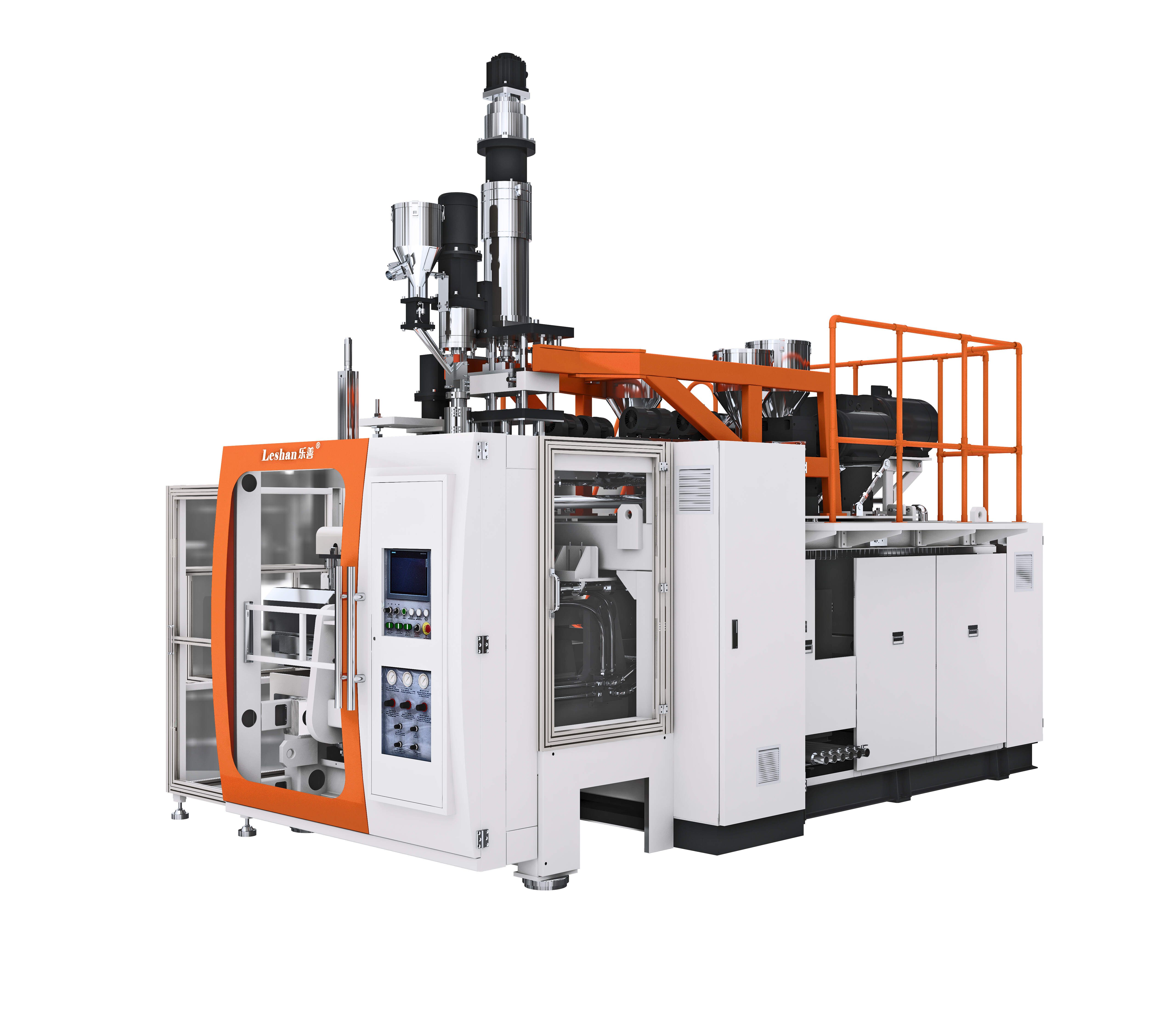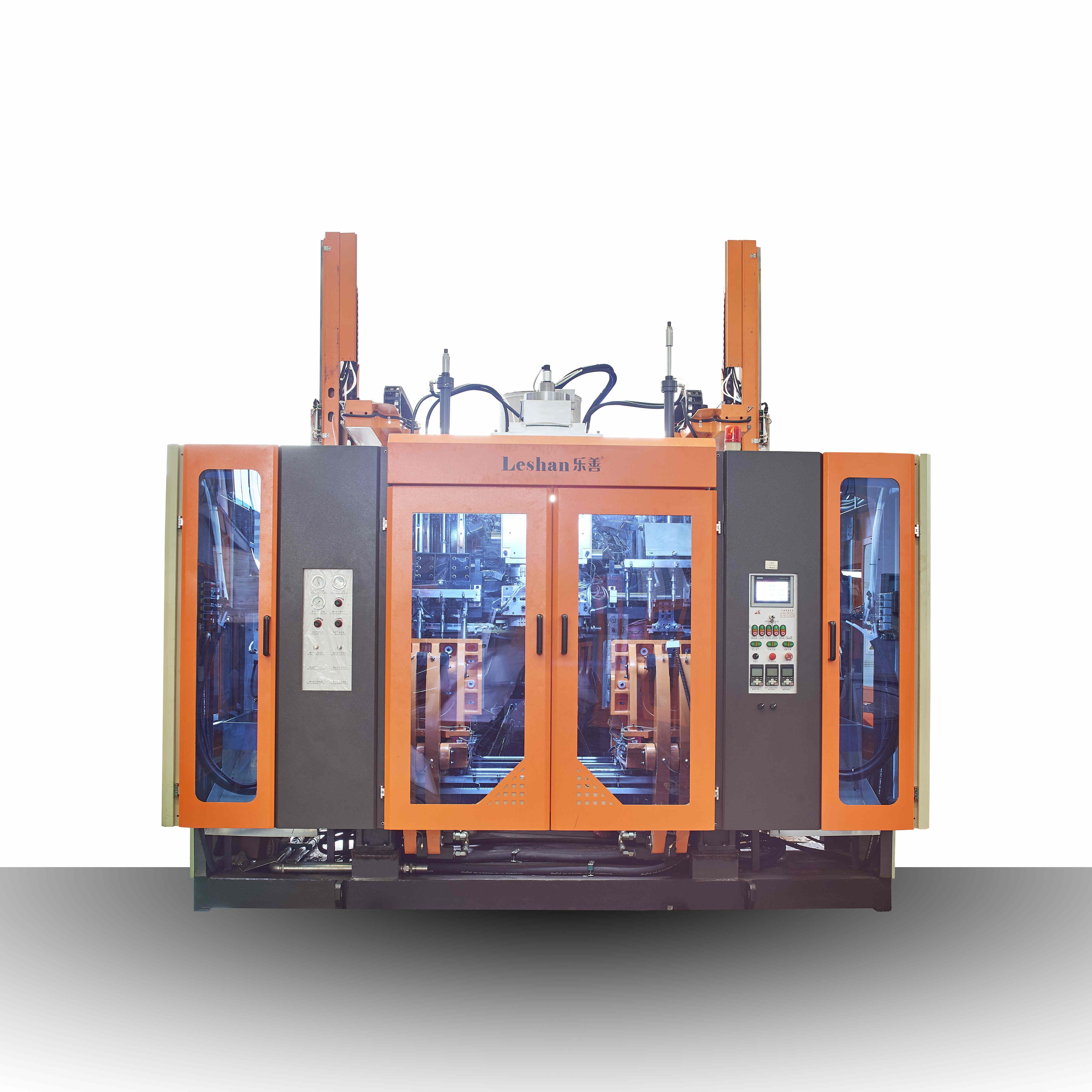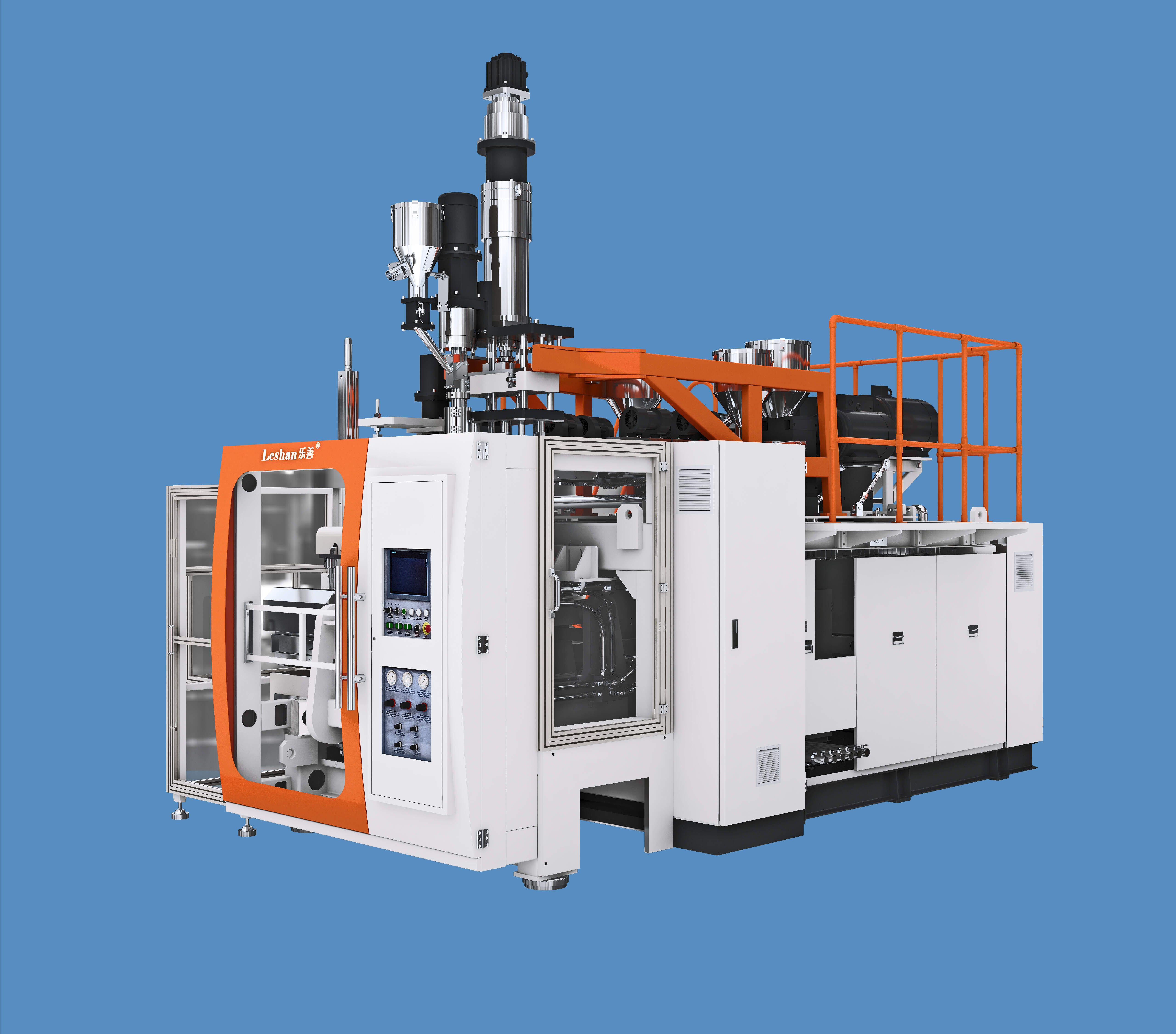
Extrusion Blow Mold Tool
Extrusion Blow Mold Tool
Leshan Intelligent Equipment Company is a high-tech design and manufacturing company specializing in the production of blow molding machines and molds. Our products include: Irregular shape product blow molding machine,Auxiliary machine,Blowing Mould & Injection Mould,Food bottle blow molding machine,Engine oil bottle blow molding machine,athlon series hydraulic machine,Cleaning bottle blow molding machine,Milk bottle blow molding machine,Extrusion Die Head,Daily chemistry bottle blow molding machine,Chemical barrel blow molding machine, etc. We will continuously strive to meet the needs of our customers and seek development together with them. At present, our products are exported to more than 50 countries and regions such as Russia, Australia, Poland, Saudi Arabia, and Bangladesh.
Our company also brought in the Germanic technical 3D scanner which is exclusive used for mold-designing . The advanced Leshan Blow Molding Machine working with the superior Leshan Mould makes the production speed faster and the production quality the topest. Leshan Hydraulic Blow Molding Machine is adopted by many listed companies and China's top 500 enterprises, such as Monarch,Kunlun,Unilever,Cnice,BlackCow Food,Bawang,Yili,Sinopec,Walch, ect.
| Parameter | Information |
|---|---|
| Product Name | extrusion blow mold tool |
| Brand Name | Leshan |
| Place of Origin | Foshan,China |
| Plastic Processed | ABS,EVA,PA,Polystyrene,PP,HDPE,PC...etc |
| Air Pressure(MPa) | 0.8 MPa |
| Color | Customized Color |
| Delivery Time | 45 days |
| Port | ShunDe/GuangZhou/ShenZhen China |
| Export region | Europe,Oceania,America |
| Export Country | Russia, Australia, Poland,Samoa,Guam,Saint Kitts and Nevis,Anguilla...etc |
| Application | Bottle |
| OEM/ODM | Acceptatble |
| Core Components | Pressure vessel,Pump,Engine,Gearbox,Bearing...etc |
| Voltage | 380V |
| Service | Free spare parts... |
| MOQ | 1 set |
| Certification | ISO9001,CE... |
| Supply Ability | 500 Set/Sets per Month |
| Weight (T) | 5-18(According to specific model) |
| Packaging Details | Standard exporting machine packing with plastic film |
| Lead time (days) | 70 (To be negotiated) |
Please note: The above table data is for reference only. For specific information, please contact us.

extrusion blow mold tool also has the characteristics of high efficiency, energy saving and environmental protection. During the manufacturing process, the blow molding machine can reduce energy consumption and the generation of emissions by recycling waste gas and waste liquid, thereby achieving the purpose of energy saving and emission reduction.
In addition, the blow molding machine can also use multi-layer molds to provide products with composite properties and increase the added value of the product.

extrusion blow mold tool---FAQs Guide
2.What is the level of automation of extrusion blow mold tool?
3.Why does the blow molding machine make so much noise when it exhausts?
4.What is the output of extrusion blow mold tool?
5.What are the key components of a extrusion blow mold tool?
6.How to choose the mold head of a extrusion blow mold tool?
7.How does the extrusion blow molding process differ from injection blow molding, and what types of products are typically produced using each method?
8.About extrusion blow mold tool,What shall I provide to you for offer?
9.How to control the energy consumption of extrusion blow mold tool?
1.What is the cost composition of extrusion blow mold tool?
We focus on providing high extrusion blow mold tool quality products and services.
The cost composition of blow molding machines can vary depending on the type and size of the machine, as well as the manufacturer and country of origin. However, the general cost composition can be broken down into the following components:
1. Machine base: This includes the main frame, base plate, and other structural components of the machine. It typically accounts for 20-30% of the total cost.
2. Extruder: The extruder is the heart of the blow molding machine and is responsible for melting and shaping the plastic material. It can account for 30-40% of the total cost.
3. Molds: Molds are used to shape the plastic material into the desired product. The cost of molds can vary greatly depending on the complexity and size of the product being produced. It can account for 20-30% of the total cost.
4. Control system: The control system includes the electrical and electronic components that control the operation of the machine. It can account for 10-15% of the total cost.
5. Hydraulic system: The hydraulic system is responsible for providing the necessary pressure and power to operate the machine. It can account for 5-10% of the total cost.
6. Other components: Other components such as motors, pumps, valves, and sensors can also contribute to the overall cost of the machine.
In addition to these components, the cost of blow molding machines may also include expenses such as labor, transportation, and installation. It is important to note that the cost composition may vary depending on the specific features and capabilities of the machine.
2.What is the level of automation of extrusion blow mold tool?
We have advantages in marketing and channel expansion. Suppliers have established good cooperative relations, continuously improved workflows, improved efficiency and productivity, and provided customers with high -quality products and services.
The level of automation of blow molding machines can vary depending on the specific machine and its capabilities. Some blow molding machines may have basic automation features such as automatic preform loading and bottle ejection, while others may have more advanced automation capabilities such as automatic mold changeovers, robotic handling of bottles, and integrated quality control systems. Overall, the level of automation in blow molding machines has increased in recent years with the development of new technologies and advancements in the industry.
3.Why does the blow molding machine make so much noise when it exhausts?
The exhaust valve is blocked or the exhaust valve and exhaust pipe are too small.
4.What is the output of extrusion blow mold tool?
We have a good reputation and image in the industry. The quality and price advantage of extrusion blow mold tool products is an important factor in our hard overseas market.
The output of blow molding machines is plastic products, such as bottles, containers, and other hollow objects. The exact output will vary depending on the size and type of machine, as well as the production speed and efficiency.

5.What are the key components of a extrusion blow mold tool?
Our extrusion blow mold tool products have competitive and differentiated advantages, and actively promote digital transformation and innovation.
1. Extruder: This is the main component of a blow molding machine, which melts and forms the plastic material into a parison (hollow tube).
2. Die Head: The die head is responsible for shaping the parison into the desired shape and size.
3. Clamping Unit: This unit holds the mold in place and provides the necessary pressure for the blowing process.
4. Blow Pin: The blow pin is used to inflate the parison and shape it against the mold.
5. Cooling System: After the parison is blown and formed into the desired shape, a cooling system is used to cool and solidify the plastic.
6. Ejection System: Once the plastic has cooled and solidified, the ejection system removes the finished product from the mold.
7. Control System: The control system is responsible for monitoring and controlling the various components of the machine, such as temperature, pressure, and speed.
8. Mold: The mold is a crucial component of a blow molding machine, as it determines the final shape and size of the product.
9. Hydraulic System: The hydraulic system provides the necessary power and pressure for the various movements and functions of the machine.
10. Electrical System: The electrical system supplies power to the machine and controls the various electrical components.
11. Safety Features: Blow molding machines are equipped with various safety features, such as emergency stop buttons, safety guards, and sensors, to ensure safe operation.
6.How to choose the mold head of a extrusion blow mold tool?
We pay attention to the introduction and training of talents, scientifically regulate the management system, and focus on cultural construction and team cohesion.
1. Determine the type of blow molding machine: The first step in choosing the mold head is to determine the type of blow molding machine you have. There are three main types of blow molding machines: extrusion blow molding, injection blow molding, and stretch blow molding. Each type requires a different type of mold head.
2. Consider the material: The material you will be using for your product is also an important factor in choosing the mold head. Different materials have different properties and require different mold heads. For example, if you are using a high-density polyethylene (HDPE) material, you will need a mold head with a larger opening to accommodate the material's higher melt flow rate.
3. Determine the shape and size of the product: The shape and size of the product you want to produce will also play a role in choosing the mold head. The mold head needs to be able to create the desired shape and size of the product. If you are producing a complex shape, you may need a mold head with multiple cavities or a custom-made mold head.
4. Consider the production volume: The production volume also needs to be taken into account when choosing the mold head. If you are producing a large volume of products, you may need a mold head with multiple cavities to increase production efficiency.
5. Check the compatibility with the machine: It is important to ensure that the mold head you choose is compatible with your blow molding machine. The mold head needs to fit securely and work seamlessly with the machine to produce high-quality products.
6. Look for quality and durability: The mold head is a crucial component of the blow molding process, and it is important to choose one that is of high quality and durable. Look for mold heads made from high-quality materials and with a good track record of performance.
7. Consider the cost: The cost of the mold head is also an important factor to consider. While it is important to choose a high-quality and durable mold head, it is also important to stay within your budget. Compare prices from different suppliers and choose one that offers a good balance of quality and cost.
8. Consult with experts: If you are unsure about which mold head to choose, it is always a good idea to consult with experts in the field. They can provide valuable insights and recommendations based on your specific needs and requirements.
7.How does the extrusion blow molding process differ from injection blow molding, and what types of products are typically produced using each method?
We have been working hard to improve service quality and meet customer needs.
Extrusion blow molding and injection blow molding are two different processes used to manufacture plastic products. While both methods involve melting plastic and shaping it into a desired form, there are some key differences between the two.
Extrusion blow molding is a process in which a molten tube of plastic, called a parison, is extruded through a die and then inflated to form a hollow product. The parison is then cooled and the mold opens to release the finished product. This process is commonly used to produce bottles, containers, and other hollow objects.
On the other hand, injection blow molding involves injecting molten plastic into a mold cavity, where it is then cooled and solidified. The mold then opens to release the finished product. This process is commonly used to produce small, complex, and precise products such as medical devices, pharmaceutical packaging, and small bottles.
One of the main differences between the two processes is the way the plastic is shaped. In extrusion blow molding, the plastic is shaped by the inflation of the parison, while in injection blow molding, the plastic is shaped by the mold cavity.
Another difference is the type of molds used. In extrusion blow molding, the molds are typically made of two halves that come together to form the desired shape. In injection blow molding, the molds are usually made of a single piece that is opened and closed to release the product.
The type of plastic used also differs between the two processes. Extrusion blow molding is typically used for high-density polyethylene (HDPE) and polyethylene terephthalate (PET) plastics, while injection blow molding is commonly used for polypropylene (PP) and polyethylene (PE) plastics.
In terms of product applications, extrusion blow molding is commonly used for larger, more simple products such as bottles and containers, while injection blow molding is used for smaller, more complex products such as medical devices and pharmaceutical packaging.
In summary, extrusion blow molding and injection blow molding are two different processes used to manufacture plastic products. While both methods involve melting plastic and shaping it into a desired form, they differ in the way the plastic is shaped, the type of molds used, and the types of products produced.
8.About extrusion blow mold tool,What shall I provide to you for offer?
Please send us your bottle picture with width,length,weights etc and better to send samples.

9.How to control the energy consumption of extrusion blow mold tool?
We are a professional extrusion blow mold tool company dedicated to providing high quality products and services.
1. Use energy-efficient machines: When purchasing blow molding machines, opt for models that are energy-efficient and have a high energy star rating. These machines are designed to consume less energy while still maintaining high production efficiency.
2. Regular maintenance: Regular maintenance of the machines is crucial in controlling energy consumption. This includes cleaning and lubricating the machines, checking for leaks, and replacing worn-out parts. A well-maintained machine will operate more efficiently and consume less energy.
3. Optimize production processes: Analyze the production processes and identify areas where energy consumption can be reduced. For example, reducing the amount of air pressure used in the blowing process can significantly reduce energy consumption.
4. Use energy-saving features: Many blow molding machines come with energy-saving features such as automatic shut-off, idle mode, and variable speed drives. These features can help reduce energy consumption when the machine is not in use or operating at a lower speed.
5. Monitor energy usage: Install energy meters to monitor the energy consumption of the machines. This will help identify areas where energy is being wasted and allow for adjustments to be made to reduce consumption.
6. Use energy-efficient materials: The type of material used in the blow molding process can also affect energy consumption. Opt for materials that require less energy to heat and mold, such as lightweight plastics.
7. Implement energy management systems: Consider implementing an energy management system that can track and analyze energy usage in real-time. This will help identify patterns and areas for improvement.
8. Train employees: Proper training of employees on the operation and maintenance of the machines can help reduce energy consumption. They should be aware of energy-saving practices and encouraged to follow them.
9. Turn off machines when not in use: Make it a practice to turn off the machines when they are not in use, such as during breaks or at the end of the day. This will help save energy and reduce unnecessary wear and tear on the machines.
10. Regularly review and update energy-saving strategies: Regularly review and update your energy-saving strategies to ensure they are still effective. As technology advances, new energy-saving techniques may become available, so it is essential to stay informed and make necessary changes.
Tags: gallon blow molding machine , large extrusion blow molding
